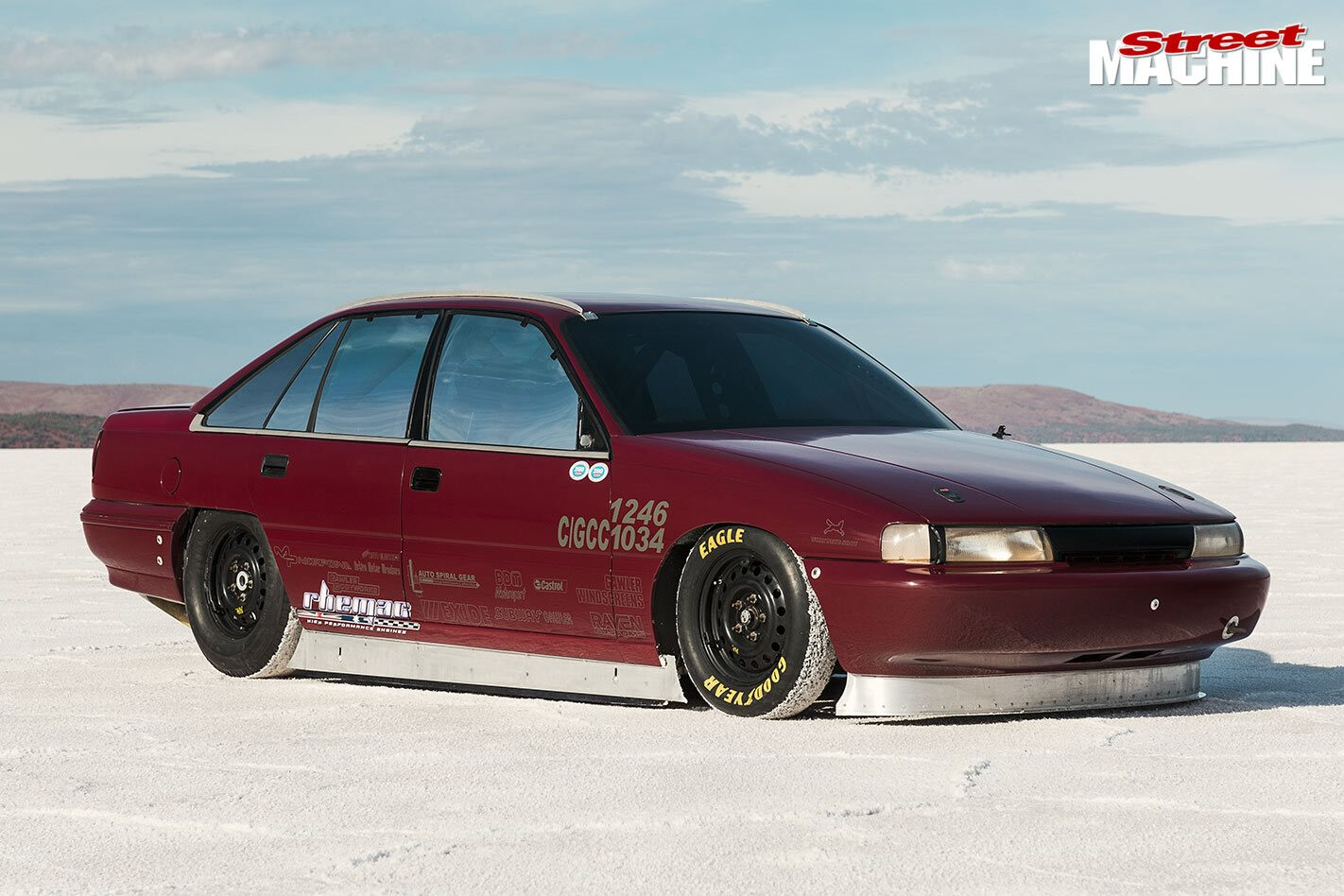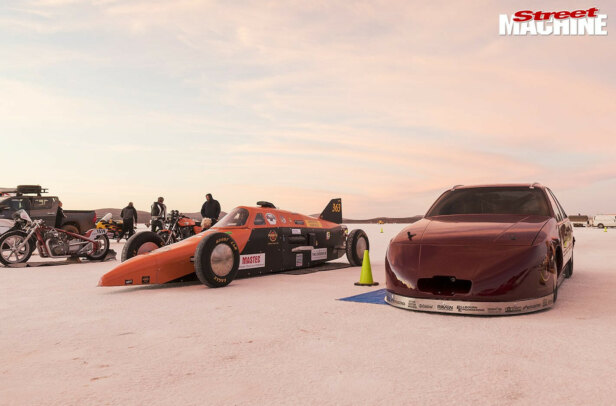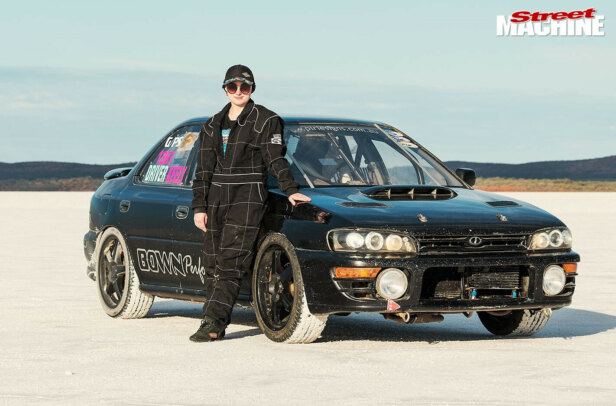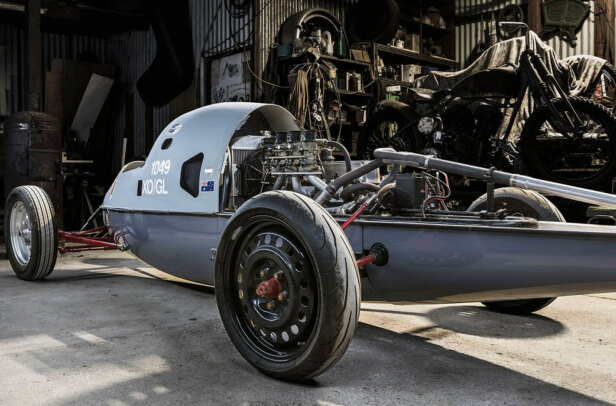This article on was originally published in Street Machine’s LSX Tuner magazine #8, 2018
MOTORSPORT doesn’t come any more eccentric than land speed racing. In this country it happens only once a year on Lake Gairdner, an enormous dry salt lake in the South Australian outback. There are no rain dates, and Speed Week has been washed out six times in its short 30-year history, so salt racers are a patient lot. The sport has its own controlling organisation – Dry Lakes Racers Australia – and the event is entirely run by the racers themselves.
The race cars are also unique to the sport, but it hasn’t always been thus. There was a time when you could run what ya brung, with street rods, street machines and drag cars lining up alongside tractors, vintage cars and purpose-built salt racers. But accidents do happen, sometimes at very high speeds, and it’s a long way to get to the nearest hospital.
Specific technical rules have evolved accordingly in terms of rollcages, fire suppression and other aspects of driver safety, to the extent that these days virtually every car competing at DLRA Speed Week is a dedicated salt racer.
Enter South Australian Tom Noack and his giant-killing, budget-built 200mph-plus VN Commodore.
The new side skirts are an interesting old-school design. “The bottom 20mm of the skirt is nylon and is sandwiched between two pieces of aluminium,” Tom says. “If it hits anything, it pushes up underneath the car rather than breaks. So a bit of vintage Formula 1 technology there.” This system allows the team to set ground clearance as low as they dare in the knowledge they have a couple of centimetres of give up their sleeves
“We were originally going to do a space-frame Camira, only because that was what was in the driveway,” Tom explains. “A friend who got me interested in the sport, John Dickenson, worked for Rhemac Motors in Willaston. A tired old V6 Commodore came in as a tow-in with the engine light on. The owner couldn’t afford to fix it or to tow it away, so he chose to leave it there. The inspection fee was $45 and we got the car for that. We started stripping it in their workshop the next week and found $6 in the back seat, so it cost us $39. It was the cheapest part of the whole build.”
Tom had made his first trek to the salt in 2009 to support John, who was having a crack in a VL Commodore.
“We came back in 2010 but without the VL,” Tom says. “We were sitting in front of the canteen beside the lake, having a few drinks, and that’s when we decided to build a race car. We listed everything that we needed and had the whole plan worked out by the time we were back on the bitumen.”
Tom bought the $39 Commodore the following month and immediately set about transforming it into a salt racer.
As the build progressed, close friends became aware of the project and the brains trust surrounding the VN began to swell.
“There was just John and myself to start with and then the father-in-law, Ian Bockmann, wanted to get involved. Ian Teusner, a machinist by trade, jumped on board, as did another mate, Brody Baker, who was a mechanical engineer working up on the WA north coast. He heard about it, quit his job and spent the next eight months helping to build the car!
“Then we met Andy Ortlepp and his two sons, Tom and Matthew. We had asked them to build a diff and they asked why we’d want anything with 2.6 gears? We said we were building a land speed car and they said, ‘Yep, we’re in, how can we help?’”
A month and a half into the build, the project went to a new level when the car was moved to Andy’s place.
“He’s got the full set-up,” says Tom. “If he ain’t got it, it’s not worth having! So the car spent the next 10 months there. The only things we outsourced were decoding the factory ECU and the paintjob, which was donated by North Para Body Shop.”
The tint on the side and rear windows is from the aviation industry, and common on light aircraft. Windows are made from Lexan, which ‘breathes’ and causes normal automotive tints to bubble
A lot of other businesses in Willaston and Gawler also helped out with advice, materials or money.
“John Dickenson was the brains behind the build as he had competed before and is a very experienced mechanic. We engineered the car from the outset to be able to run 200mph, but our first goal was 169mph, the existing record that had stood for 10 years.”
The interior was stripped and a DLRA-spec rollcage fabricated, which has thicker-wall tubing than required by ANDRA, for example. As well as protecting the driver, the ’cage stiffens the chassis, which was duly treated to a four-link rear with adjustable coil-over shocks at both ends.
The front end also scored a sway-bar and shock tower brace, but is otherwise scarily standard, even down to the brakes. There is a parachute, which can be used at the driver’s discretion. In Tom’s case, apart from letting it go as a requirement of his 175mph licensing pass, or if the car ever gets loose, he tends to leave it packed. With 160 kilometres of braking area, there’s plenty of space to wash off speed.
High-speed-rated radials were used initially, but specialist land speed tyres were required as Tom approached the 200mph mark, along with roof rails to stabilise the car at high speed and Lexan side and rear windows.
“Surprisingly, the engine is a fairly basic set-up,” claims Tom. “Our goal was always to set the car up handling-wise and achieve the highest speed possible before we went too radical with the engine.”
The mill in question is an L98 Chev crate motor with air intake, camshaft, valve springs and extractors built by Andy. It’s good for 320kW at the treads, or 426rwhp.
The exhaust originally exited under the car, but was replaced in 2015 with larger three-inch pipes shooting straight out the back.
“It’s supposed to fill the void behind the car with hot air and reduce drag,” Tom explains, “but no two runs are ever the same so its effectiveness is difficult to evaluate.”
The gearbox is a stock T56 six-speed manual, with Tom using only the first four gears, as fifth and sixth are overdrives. The diff is a Commodore limited-slip Salisbury with 2.6 gears from a VK pursuit car. The engine revs as high as 7200rpm and Tom says it’s doing around 6600rpm in fourth at 206mph.
“You don’t spend a lot of time looking at the tacho,” he says.
The car was completed within a year and ready to rock for Speed Week in March 2011 after a late rush of bruising 16-hour days.
“And then it rained,” Tom says, and the event was cancelled at the last minute. “A mate was in the supermarket and had a shopping trolley full of food for the whole crew when the call came through. He looked left and right, and then just walked away.”
Such are the vagaries of land speed racing, but there was always next year! Then, when next year did roll around, Speed Week was washed out again!
And so the VN and its patient owner and crew finally made their debut in 2013, a full two years after the car was finished. But the nightmare wasn’t quite over.
Tom’s first job was to work his way through his qualifying passes – first 125mph, then 150mph, then 175mph – and things didn’t initially go well. “The car was that unstable it was absolutely frightening,” he recalls.
The car was using up all of the track, with very little in the way of steering due to the front getting light. Veteran salt racer John Lynch (the only Australian to ever go faster than 300mph on Lake Gairdner) advised Tom to add a spoiler to the front, which the team fabricated in the pits from some borrowed alloy sheets.
Sure enough, it settled down sufficiently for Tom to successfully complete his 175mph ‘parachute run’, which gave them the class record. He then went 188mph, smashing the previous class record by almost 20mph.
“It had no weight in it,” he says. “We were 600 or 700kg lighter than the 200mph cars, so we put weight back into the car and built a decent front spoiler.”
Tom returned in 2014 along with rookie co-driver Darryn Weeks, who had joined the team after the rain-out and crewed in 2013. Tom added just one mph to his own record, while Darryn ticked off his licensing passes. Then, in 2015, Tom came tantalisingly close to the Holy Grail with 199.490mph, alongside 180mph for Darryn. Both drivers exceeded 200mph the following year, with Tom earning membership of the hallowed 200mph Club (and a coveted ‘red hat’) for a new record speed of 203.126mph against Darryn’s 202.554mph.
In 2017 the Commodore was lightly modified with an enclosed front bar, which put Darryn into a new altered class where he ran 205.950mph against a 172mph record to also join the 200mph Club, while Tom ran his highest speed to date of 206.469mph. Young Tom Ortlepp also had a steer, working his way through his 125 and 150mph qualifying passes. Side skirts (a form of streamlining) were then added for this year to put them in the competition coupe class and another record of 205.761mph for (old) Tom. That’s more than 330km/h in the new money – not too shabby for a $39 VN Commodore (which does wear some body parts from a later VP)!
“These achievements would not be possible without the huge efforts from all who gave up their time and helped in the build and all who have crewed and travelled to support us,” Tom says. “It really is a huge team effort.”
For the future, a blower is on the cards if Tom can attract another sponsor. In the meantime, his aim is to share the love and get a few more friends their own ‘red hats’.
And how about that mighty General Motors L98 six-litre, huh?
“Yes, being a Ford man, I have new respect for the LS engine, especially as a basic standard unit,” Tom says. “We would never be running these speeds with a factory Ford engine with the same modifications. As for reliability, we can run 200mph off the trailer. I’ve changed the sparkplugs once.”
TOM NOACK
1991 HOLDEN VN COMMODORE
Paint: Wine Red
GRUNT
Type: Chev 6.0-litre L98
Valve train: Lunati valve springs and retainers, Crane hydraulic camshaft, 1.7:1 rockers
Induction: Custom OTR intake
Other stuff: Rhemac sump, Levett engine pulleys, Bosch 044 fuel pump, VL RB30 radiator, twin thermos
Exhaust: Custom 17/8in primaries and dual 3in tailpipes
Engine management: Retuned factory ECM
BENEATH
Transmission: VE six-speed manual
Clutch: Xtreme HD
Diff: VK Salisbury with 2.6:1 gears
Suspension: HDS coil-overs with King springs (f), McDonald Bros coil-overs with QA1 springs and shocks (r), Rod-Tech Panhard bar, adjustable four-link, strut brace
Brakes: Factory VN with delete brake booster kit, Moroso extended wheel studs
ROLLING
Rims: Welded steel; 15×4 (f), 15×6 (r)
Rubber: Goodyear Eagle Land Speed (f), Dunlop Racing (r)




Comments